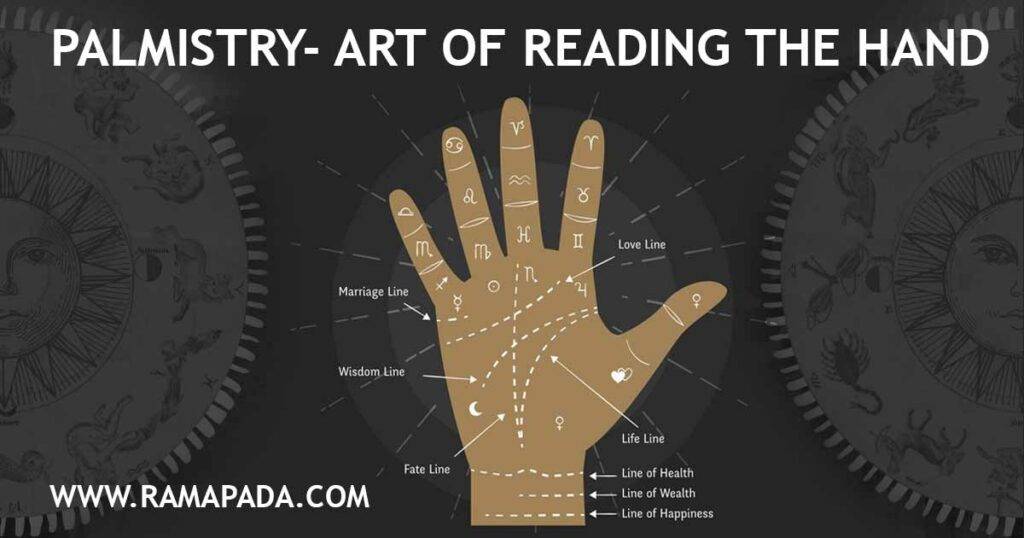Palmistry- Art of Reading the Hand, also known as Chiromancy or Hasta Samudrika Shastra in Indian tradition, is the mystical practice of interpreting the lines, shapes, and mounts of the hand to reveal insights about a person’s character, destiny, and spiritual path. Rooted in ancient Indian and Chinese astrology, and later refined in Greek and Roman traditions, palmistry continues to fascinate seekers of self-knowledge and cosmic connection.
Origins and Cultural Roots
- Indian Roots: Palmistry is deeply embedded in Vedic traditions, where it is considered a branch of Samudrika Shastra—the science of body signs.
- Global Spread: From India, it travelled to China, Tibet, Persia, and Europe. Aristotle is said to have introduced it to Alexander the Great, who used it to assess his generals.
- Modern Revival: In the 19th century, figures like Cheiro popularised palmistry in the West, blending Eastern mysticism with Western esotericism.
The Major Lines and Their Meanings
Palmistry focuses on several key lines, each offering a window into different aspects of life:
| Line | Symbolism |
| Heart Line | Emotional depth, love life, and capacity for compassion |
| Head Line | Intellect, decision-making, and communication style |
| Life Line | Vitality, health, and major life changes—not the length of life itself |
| Fate Line | Influence of destiny and external forces on one’s life path |
| Sun Line | Fame, creativity, and public recognition |
| Marriage Lines | Romantic relationships and emotional bonds |
Each line’s length, depth, curvature, and intersections reveal nuanced meanings, often interpreted in relation to planetary mounts and finger shapes.
Mounts and Planetary Influences
The raised areas beneath each finger are called mounts, each associated with a planet:
| Mount | Planet | Traits Reflected |
| Mount of Jupiter | Jupiter | Ambition, leadership, spirituality |
| Mount of Saturn | Saturn | Discipline, responsibility, introspection |
| Mount of Apollo | Sun | Creativity, charisma, fame |
| Mount of Mercury | Mercury | Communication, wit, business acumen |
| Mount of Venus | Venus | Love, sensuality, vitality |
| Mount of Luna | Moon | Imagination, intuition, emotional depth |
| Mount of Mars | Mars | Courage, aggression, resilience |
A well-developed mount suggests strong planetary influence, while a flat or underdeveloped one may indicate a lack of those traits.
Hand Shapes and Elemental Types
Palmistry also classifies hands into four elemental types, each reflecting a dominant personality style:
| Element | Hand Shape | Personality Traits |
| Earth | Square palm, short fingers | Practical, grounded, reliable |
| Air | Square palm, long fingers | Intellectual, communicative, analytical |
| Water | Long palm, long fingers | Emotional, intuitive, artistic |
| Fire | Long palm, short fingers | Energetic, passionate, impulsive |
Palmistry and Spiritual Insight
In Indian traditions, palmistry is not just predictive—it is karmic and spiritual:
- Lines evolve with choices and spiritual growth.
- Right hand (for right-handed people) reflects current karma and conscious actions.
- Left hand reveals inherited traits and subconscious tendencies.
Palmistry- Art of Reading the Hand – thus becomes a mirror of the soul, offering guidance rather than fixed fate.
Contemporary Relevance
Despite scepticism, palmistry remains popular in spiritual circles, counselling, and even psychological profiling. It is often used to:
- Understand relationship dynamics
- Explore career inclinations
- Reflect on karmic patterns
- Enhance self-awareness and mindfulness
Conclusion: The Hand as a Cosmic Map
Palmistry- Art of Reading the Hand – invites us to see the hand not just as a physical tool but as a cosmic manuscript, etched with the stories of our past, present, and potential future, said by the palmist in India. Whether approached as a science, an art, or a spiritual practice, it reminds us that destiny is not fixed—but written in lines we can learn to read and reshape.

